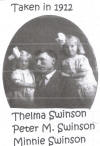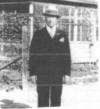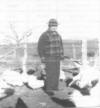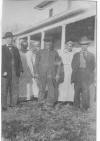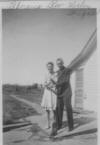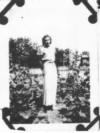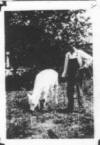Peter M. and Mary
Christensen-Lillebo-Swinson
|
Peter Swinson, 1912 |
Peter with daughters and Minnie |
Peter |
Peter and his chicks |
|
| Front: Sam
Swanson, Otto and Peter Swinson. Back: Mary
Swinson and Josie Swanson. Sam and Otto were Pete's half-brothers (Their mother was Randvei Oldstd. Mary is Peter's wife; Josie is Sam's. |
Florence Swinson-Gifford |
Pearle Swinson-Carson |
Pete with his white calf |
This is the home and dairy of Pete and Mary Swinson located in Presho south of the tracks by Medicine Creek. |
Peter Michael Swinson, born April 3,1862 in Vinji) Norway, His parents were Mikkel Svindson and Sijvor Johannesdatter. His mother died when he was four and his father remarried, He would have four siblings and eight half brothers and sisters. He came to America when he was 17 years old. He became a citizen on October 24, 1892. On January 18, 1907, he married Mary Christensen Lillebo, a widower of 30 with two young sons, Hilmer and Edwin. Map of Norway Migration map
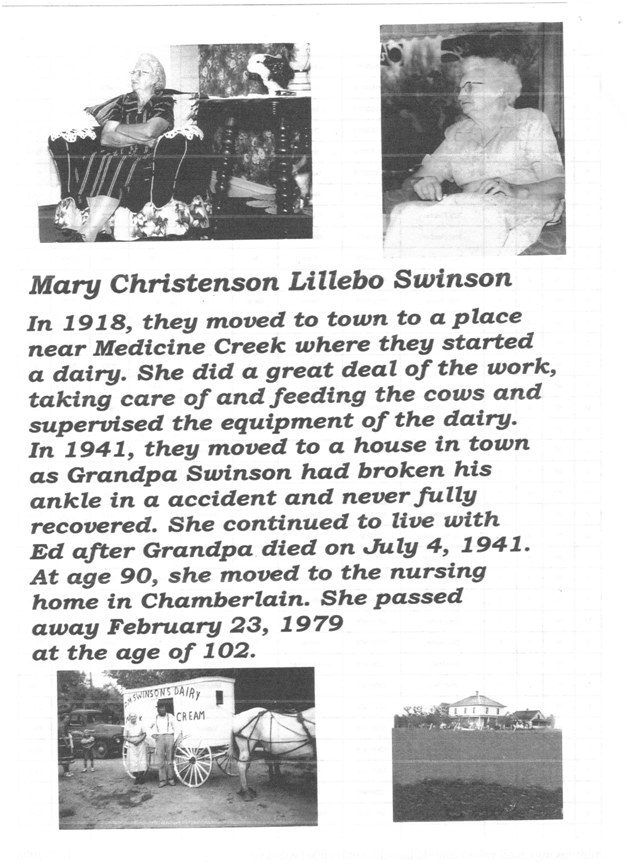
|
Peter M. Swinson,
a native of Norway came to Lyman
County in 189,2 and took up a claim in Hilmoe
Township. He lived in a log house which he
built from White River trees He was known
by all the cowboys who rode the range as a
fine bread baer (Mrs Swinson tells how
before they were married she would see the
cowboys stop at his house, even though he
wasn't home, and come out with a whopping big
slice of bread in their hands ) "Pete" baked
his bread big—in an oversized Dutch
oven. He could bake and cook most
anything else, too.
A few years before he died,
daughter Thelma decided to make some doughnuts
something she knew very little about.
They turned out to be sinkers. Pete said, "You
know, I think they'd have been a little
better if you'd have put
in a couple more eggs." It
dawned on Thelma then and there that she
hadn't put in ANY. |
a number of fine fat
ducks, but he wore a puzzled look on his
face because these weren't like any he
had ever seen before. Then it dawned on him.
You guessed it — they were tame and farm
raised. Pete got a big laugh out of that. |
They lived in a log
house which was built by his father, Michael. They
eventually built up a 1500 acre
ranch. They had five children, Minnie, Thelma,
Florence, Pearle, and Parnell. He retired
from ranching in
1918 and moved to Presho, SD. About a
year later, he started a dairy. After a
accident that injured his ankle, he retired. On
July 6, 1942, he died
at home of cancer of the digestive system.
|
Peter M. Swinson by Sharon L. Schmidt According to Dad he was born March 3,1862, (the parish records say April 3) in Vinje, Norway. His parents were Mikkel Svendson, Fliseram, and Sigvor Johannaadatter, Sundvesflyne who lived at Vinje Sogn near Voss in Bergen County. Ha was the fourth of five children born to them. When he was four his mother died and his father married again. Subsequently he would have 8 more half brothers and sisters. In 1875 his father and stepmother Randvei with their four children went to the United States leaving Peter and his brothers and sister behind. Four years later, Dad, at 17, came to the United States landing at the lake port of Detroit and then went on to Arcadia in Trempealeau County, Wisconsin Migration map When Dad came to Dakota is not sure. In the 1915 census he said he had been in the United States 36 years and in South Dakota 31• This would indicate he came in 188I, but his application for citizenship was made at Yankton April 2, 1883, when he was 21 years old. I believe he worked at a hotel in Yankton for some time. On October 24,, 1892, Dad renounced his allegiance to the king of Norway and became a citizen of the United States in the circuit court of Yankton County. On May 30, 1893, he made application for homestead land in what was then Presho County. It was made at Chamberlain with his address listed as Freeman, S.D. Historical reports have him in Presho County in 1892. He may have been out to inspect the land before 1893. He later relinquished this application (#1837) in order to make a second. On March 19, 1901, he applied for 40 acres of Sioux Indian land No. 41197 - final file No. 1145. The rest of the 160 acres was for public land, application No. 1176 and final file No. 545• The legal description of this land is "SE ¼ of NE ¼ of section 24 in Twp. 104 North of Range 79 West of principal meridian in South Dakota containing 40 acres. Lots numbered 2 and 3 and the NE ¼ of the SW ¼ of Section 19 in Twp. 104 N of Range 78 W of the 5th principal meridian in South Dakota containing 111 acres and 26/100 of an acre." In 1906, in making final proof that he had fulfilled conditions of the homestead, he said, "Built my house on the land which was a part of a former entry 10th July 1893. Established residence 20th May 1894. Log house 13 x 15, 6 ft. high; frame barn 24 x 100; 6 ft. posts, chicken house 14 x 16 – logs, small barn 16 x 24 - logs; good well, good dam, 1 acre breaking, 100 rods fencing. Value about $1400." He also said he had not been absent from the land since making settlement. In 1907, when he made final proof he said he was grazing 250 head of livestock and had 30 chickens. At this time he was a married man when he was almost 45. On January 18, 1907, he married Mary Christensen Lillebo, a young widow of 30 with two young sons, Kilmer and Edwin. She too was a homesteader who lived just across the dividing line between Sioux and Hilmoe townships. Dad's was in Hilmoe, hers in Sioux. They lived in Dad's log house which was built by his father, Michael. I remember it as the grass and weeds growing out of the roof fascinated me. He told us that he woke up one night while he lived here and found a rattlesnake in his bed. Rattlesnakes were very numerous inhabiting the prairie dog towns which were found all over. The most common sound that broke the silence of the prairie in my father's homesteading days was the lonely howl of the coyote. Dad was more of a rancher than a farmer although he was both. He built a big herd of Hereford cattle (no other kind would do) and at one time he had about 135 head of horses. Some were broke for work and riding. All farm work was done with horses. During the war there was a great demand for horses and most of them that were not needed were sold. Livestock was watered at two dams and a shallow well pumped by windmill. In about 1926, a flowing artesian well was dug. In later years it had to be pumped. Dad's and Mother's combined homesteads plus land bought from people who moved away eventually became a 1500 acre ranch. Soon after they were married, they started to build a new house. When the basement was completed, they moved in. The house was finished about 1908. There were five children born here; Minnie, Thelma, Florence, Pearle and Parnell (Pete). My father built new barns and moved in two large buildings from the Russian settlement (the Russians had moved out). These were used for granaries. A small one room house was moved in and used as a summer kitchen. In 1910, Dad joined the Masonic Lodge and the Eastern Star. He also became a member of Knights of Pythias. He was a dyed-in-the-wool Republican and liked to argue politics with Democratic neighbors and he belonged to a literary club where the men met at a schoolhouse to discuss issues of the day. His philosophy was, "Don't expect government to do anything you can do for yourself." Dad was baptized shortly after birth on May 11, 1862, at Vinje in the Lutheran Church. He was a charter member of the White River United Lutheran Church. This church had a cemetery where his father Michael was buried. He was often at odds with Rev. Rolfson, a minister of the church over the Masonic Lodge so when his daughters decided they'd rather be Methodists, he did not object. In 1918, he decided to retire and move to Presho where he thought educational opportunities for his children would be better. He himself had about five years of school, but he was a self-educated man. In earlier years he always read the Norwegian paper Fremad and we always had a daily paper. About a year after we moved to town, Dad bought a house with 40 acres of pasture and farm land and began a dairy. He built a new barn and silo and the small house that his brother Otto had lived in, became the dairy house where milk equipment and bottles were washed and sterilized. Milk was also bottled here and cream separated. Dad delivered the milk to stores and about town in a milk wagon pulled by Pat and Charlie. He enjoyed this part of the dairy business because he liked people and he loved to visit. He used to say he saw the new babies (usually born at home in those days) before their fathers' did. One of the pleasant pastimes of his years in Presho was his meeting with the "Ananias Club" which met in Judge Wederath's office where they played Norwegian Whist. He served on the school board and the city council and on committees of the Republican Party. He was master of the Masonic Lodge as well as holding other offices in it. Rising early in the morning was part of his way of life - usually four or five o'clock. However, he took frequent cat naps usually after meals as he sat reading his newspapers. One day as he was returning from his milk route, a Mobil truck backed into his wagon breaking his ankle. Healing was slow and he was never very active after that. In the thirties the depression, grasshoppers, and drought brought about hard times with financial losses on the farm and in the dairy business. Just before the Second World War came along, they gave up the dairy farm and decided to salvage the ranch if possible. He and Mother moved into a house Ed bought. Shortly after this on July 6, 1912, he died at home of cancer of the digestive tract. His insurance was used to clear the ranch from the remaining debt. Dad was a temperate man in all things, but one of his hobbies was making his own beer or as he called It "home brew." It was made from water, malt, yeast and sugar. After it had set for the right length of time, it was bottled and capped, put into crates, and stored in the basement. It was usually shared with someone who came to call. The friend or relative often admitted that some of it was rather potent. Ed Lillebo says that somewhere under crates of empty bottles and boxes in the basement of his house is a crate or two of homebrew which Dad made at least 37 years ago. He was slender - about 5 feet 8 Inches tall, weighed about 155 pounds, and had blue eyes and thick black hair which was not entirely gray at 80. He still had most of his own teeth too. Dad was a very even-tempered gentle person who rarely raised his voice in anger. He preferred to leave the disciplining of the children to Mother. He was very independent, resourceful and determined to make the most of the opportunities offered in his adopted country. He believed a man should stand on his own two feet and that if he worked hard and didn't spend foolishly, he would get ahead. This he demonstrated in his own life. |

